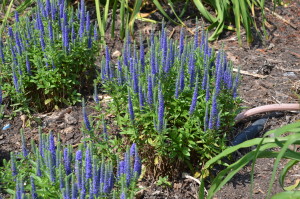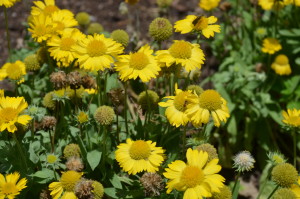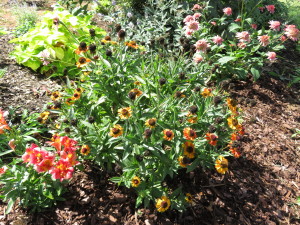Deadheading is the practice of removing spent blossoms to stimulate re-blooming. It also refreshes the plant’s appearance, and lessens the threat of seed dispersal. It redirects the plant’s energy from seed production to root and shoot growth.
Deadheading is an extra chore throughout the growing season. When the plant (perennial or annual) has stopped blooming or its appearance starts to decline, remove the entire flower stalk. Depending on species, a perennial may bloom again 2 -3 more times. Weather and soil moisture and soil fertility are also key factors.
After deadheading apply a water-soluble fertilizer such as Miracle-Gro™ or Schultz™. This is good time to clean up the bed, weed, and add organic mulch. If the soil is dry, irrigate the bed deeply with 3 – 4 hours of overhead irrigation (equivalent of 1 ½ inches of rainfall).
Many perennials do not respond to deadheading. Like other types of pruning, deadheading is plant species specific. It can be difficult to group plants (or people) into categories. For most plants remove spent flowers and stems back where they originate near the plant base. New lateral shoots should appear within a few weeks and blooms 3-5 weeks later.
Deadheading Some Perennials (this list is not complete):
These popular perennials respond to deadheading:
Yarrow (Achillea spp.)
Hollyhock (Alcea rosea)
Columbine (Aquilegia spp.)
Butterfly weed (Asclepias tuberosa)
Hardy begonia (Begonia grandis)
Canna lily (Canna spp.)
Tickseed (Coreopsis spp.)
Cheddar pink (Dianthus gratianopolitanus)
Delphinium (Delphinium spp.)
Foxglove (Digitalis spp. and cvs.)
Purple coneflower (Echinacea purpurea)
Blanket flower (Gaillardia x grandiflora)
Gaura (Gaura lindheimeri)
Geum (Geum spp.)
Sneezeweed (Helenium autumnale)
False sunflower (Heliopsis helianthoides)
Lavender (Lavandula spp.)
Shasta daisy (Leucanthemum x superbum)
Lupine (Lupinus spp.)
Bee balm (Monarda spp.)
Penstemon (Penstemon barbatus)
Garden phlox (Phlox paniculata)
Perennial salvia (Salvia nemorosa)
Pincushion flower (Scabiosa spp.)
Indian pink (Spigelia marilandica)
Stokes’ aster (Stokesia laevis)
Spiderwort (Tradescantia x andersoniana)
Spike speedwells (Veronica spicata)
Culver’s root (Veronicastrum virginicum)




 Posted in
Posted in 
